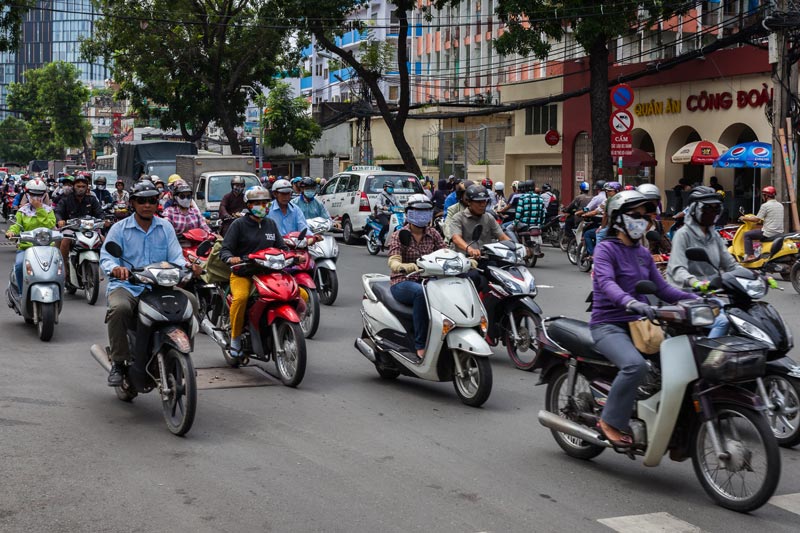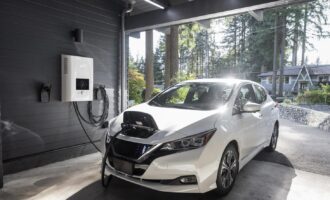
The path to lower transport emissions in Vietnam
Two-wheelers are one of the most common sights in Vietnam and, by far, the most dominant form of transportation. They account for 93.3% of all national motorised vehicles and there are more than 58 million motorcycles and mopeds registered in the country. Car ownership is extremely low in Vietnam by international standards, with a modest 38 cars per 1,000 inhabitants, according to the Vietnam Register, as of December 22, 2021. Two-wheeler ownership, on the other hand, is approximately 615 vehicles per 1,000 people.
Transport is responsible for 18% of Vietnam’s total national greenhouse gas (GHG) emissions. While two-wheelers are synonymous with Vietnam, they are also a leading cause of environmental problems in the Southeast Asian country. The large fleet of two-wheelers accounts for more than 90% of carbon monoxide and volatile organic carbon emissions, and 60% of suspended particle emissions, according to Vietnam’s Ministry of Natural Resources and Environment (MONRE).
Vietnam has committed to reducing GHG emissions and air pollution. In September 2020, it updated its Nationally Determined Contribution (NDC) with a goal of reducing GHG emissions by 9%, compared to 2014—a pledge that could be raised to 27% with international support. On January 18, 2021, Vietnam’s Prime Minister also issued the Directive on reinforcement of controlling air pollution (Directive 03/ CT-TTg).
Electrification of its two-wheeled fleet is a key component of addressing Vietnam’s environmental challenge. While the number of electric two-wheelers (e2Ws) in the country is increasing, from 4.9% of sales in 2019 to 8.3% in 2020, internal combustion engine (ICE) two-wheelers accounted for 91% of sales in 2020, according to The International Council on Clean Transportation (ICCT), a U.S.-based independent nonprofit organisation (NGO). E-mopeds reported the largest growth in electrified two-wheelers, increasing from 3.8% market share in 2019 to 7.1% in 2020, whereas electric motorcycles contributed only 1.2%.
A report published by ICCT in March 2022, Using policy and regulation to pave the way for two-wheeler electrification in Vietnam, identifies the issues that are impeding widespread adoption of e2Ws. The report reviews existing policies, regulations and standards and provides recommendations to both accelerate the uptake of e2Ws and reduce emissions from the ICE fleet.

ICCT highlighted significant gaps in Vietnam’s technical regulations and technical standards, throughout the entirety of the lifecycle of e2Ws. The authors emphasised the need to develop comprehensive regulations and technical standards for e2Ws concerning charging infrastructure, battery swapping systems, vehicle disposal and recycling of spent batteries.
The report recommended the development of a new national technical regulation specifically for e2Ws. Currently, e2Ws adhere to the same technical regulation on safety and environmental protection as ICE two-wheelers. Technical standards are also critical to the safe use and operation of e2Ws. ICCT called for comprehensive regulations and standards related to the safety of e2W users and other road users. Technical standards that currently relate to e2Ws are not mandatory.
The establishment of harmonised technical regulations and technical standards on charging infrastructure and battery swapping systems would allow users seamless access to charging facilities regardless of their vehicle models. It also enables different e2W manufacturers to cooperate in providing and operating infrastructure and services. ICCT also recommended the development of a clear set of regulations/standards that specify definitions, terminologies, and vocabularies related to e2W charging infrastructure and swapping systems to ensure uniformity. The report called for technical regulations and standards relating to e2W vehicle disposal and recycling of spent batteries/accumulators to mitigate negative environmental impacts.
ICCT emphasised the need for more stringent emission standards for ICE motorcycles to improve air quality alongside the growth of e2Ws and recommended the development of a roadmap towards Euro VI-equivalent standards. Currently, new vehicles from July 1, 2007 to 2016, only need to comply with Euro 2 emission standards. Vehicles registered from January 1, 2017, must adhere to Euro 3 emission standards. This contrasts with India which has already adopted the Euro VI emissions standard equivalent, Bharat Stage VI, in 2020. The report acknowledges that the technical standard for motorcycle emission level 4 (equivalent to Euro 4) was issued in 2020. However, it is not mandatory and Euro 3 is still applied to new motorcycles in the country.
Vietnam should also develop mandatory national standards on fuel consumption, fuel economy and carbon dioxide emissions for two-wheelers, says ICCT. While the Ministry of Science and Technology (MOST) is developing technical regulations on gasoline, diesel fuel and biofuels in line with the Euro 5 emission standards, this regulation is still not available, according to the ICCT report.
ICCT called for the early adoption of low-sulphur fuel, which requires a maximum sulphur content of 50 parts-per-million (ppm), for greater emissions reductions. Lower sulphur fuel enables the adoption of advanced emission control technologies in new vehicles and improvements in the efficiency of vehicles currently on the road. ICCT also stressed the need for strong penalties for non-compliant fuel suppliers to stem the flow of counterfeit fuels. Modern fuel standards would provide confidence to manufacturers looking to transition to a more efficient fleet.
Fuel consumption labels were mandated on new ICE motorcycles from January 1, 2022. However, vehicle energy labelling does not apply to electric vehicles. The report suggests there is an opportunity to extend the use of energy labels to e2Ws to assist customers in selecting the most efficient vehicles. Labelling could display the energy consumption of e2Ws in kWh/Km and detailed driving ranges. The report highlights the need for the development of an adequate test cycle to measure the energy efficiency of e2Ws.

In many markets there has been a positive correlation between fiscal incentives and electric vehicle adoption. ICCT highlighted the opportunity to incentivise buyers of e2Ws, who currently pay the same taxes and fees as owners of ICE two-wheelers. Current taxes include a registration fee, value-added tax (VAT), special consumption tax (SCT), vehicle licence plate fee and the mandatory civil liability insurance, paid annually. High prices are one of the top three reasons for not purchasing electric vehicles in Vietnam. The introduction of vehicle purchase subsidies, tax exemption or tax reduction and lower electricity prices were all offered as potential options to boost e2W adoption.
Vietnam’s Ministry of Transport (MOT) is currently developing an action plan to reduce emissions of in-use two-wheelers. The ICCT report emphasised that currently only newly manufactured, assembled and imported two-wheelers are subject to vehicle inspections. Periodic inspection and maintenance of in-use two-wheelers would assist in reducing emissions and noise pollution.
Pilot programs, such as confiscating old and polluting vehicles, are underway in the Southeast Asian nation. Some cities have also announced plans to limit the operation of two-wheelers. Hanoi, a city of five million motorbikes, is pursuing a complete ban on two-wheelers by 2030 to reduce soaring levels of pollution and unclog city streets. A specific action plan is currently unavailable, and it is unclear if the ban includes e2Ws.
ICCT’s report emphasised the importance of strong government support to promote electric vehicle development in the early stages. Despite a significant opportunity to improve air quality in Vietnam, specific policies supporting e2W development are largely unavailable, says ICCT.
The paper recommends the development of a roadmap for e2W adoption and a clear vision and target for e2W advancement to encourage manufacturers to shift production from ICE two-wheelers to e2Ws. Targets could include mandates on e2W production and the phase-out of ICE two-wheelers.
Vietnam requires policies to support the e2W industry, its supply chains, providers and operators of charging infrastructure, and battery swapping services. The report highlighted potential incentive policies including direct subsidies to manufacturers of e2Ws and e2W parts, reducing import tariffs on parts and raw materials for manufacturing and assembling e2Ws, and reducing the registration fee for locally manufactured and assembled vehicles. Authors Huong Le and Zifei Yang also called for policies that make owning and operating e2Ws more attractive to consumers including making e2Ws more cost-competitive and conducting public campaigns to raise awareness of the technology.








